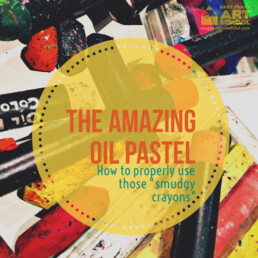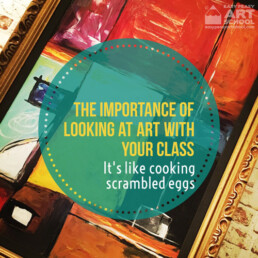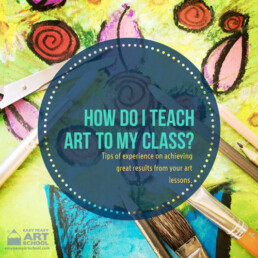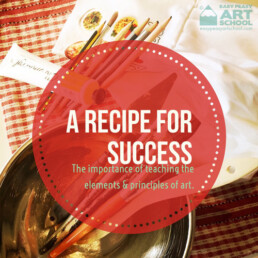The Amazing Oil Pastel
[tatsu_section padding= "90px 0% 90px 0%"][tatsu_row column_spacing= "" row_id= "" row_class= "" equal_height_columns= "1" full_width= "0" gutter= "no" layout= "1/2+1/2"][tatsu_column layout= "1/2"][tatsu_text max_width= "" wrap_alignment= "center" animation_type= "fadeIn"]
All you need to know about those funny feeling, smudgy ‘crayons'.
I love oil pastels. They are so easy to use and produce brilliant results. They are an ever popular and cost effective medium for primary and elementary schools. Yet I would argue that most teachers don’t know how to use them to their fullest potential or even worse, to my horror, refer to them as crayons!
[sc name="Brushes" color="orange" content="Introduction:" ]
I am sure most of you would have seen and probably even used oil pastels in your classroom before. Most of you might know oil pastels as those greasy feeling “crayons” that smudge easily and tend to make a mess of the students’ work. However, the oil pastel if used correctly, can prove to be a fantastic medium in which students can produce vibrant art without the preparation, mess and cleanup of paint.
[sc name="Brushes" color="blue" content="Oil Pastels Are NOT Crayons:" ]
The first thing to remember is that oil pastels are not crayons. They are very different in what they are made of and how they are used. Oil pastels use a binder made of oil and wax to hold them together. This creates the soft, creamy texture of an oil pastel and enables them to be coloured and blended on different surfaces. Whereas crayons use wax alone as their binder which makes them much harder and a little more difficult to use.
Crayons have their place in a classroom, they too are a wonderful medium, but make sure you know the difference so that you can make an educated choice when it comes to choosing a medium for your class’ art lesson.
[sc name="Brushes" color="green" content="Types of Oil Pastel:" ]
There are many different types and brands of oil pastel available to purchase for use in your classroom. They are available from most educational suppliers or art supply stores and can differ dramatically in price and quality ranging from cheap through to expensive artist quality. When purchasing oil pastels, you will need to remember a few things:
Sometimes the very cheap oil pastels are quite hard and prove to be difficult to use or blend. Make sure your oil pastels are soft enough that the students can blend and colour with relative ease.
Oil pastels can come in different sizes. For classroom use, oil pastels that are approx.10mm wide as a minimum are best. Oil pastels that are smaller than this tend to break and wear out very easily.
[sc name="Brushes" color="yellow" content="Using Oil Pastels In Your Classroom:" ]
Here are some tips on making the most of your oil pastels in the classroom.
- Use sheets of newspaper under students work to prevent marking tables and to 'clean' the oil pastels on. Oil pastels can sometimes become smudged with other colours.
- Spray finished works with fixative or hairspray to prevent smudging.
- With new boxes, try to use at least one box per two students so that hey have access to the colours they need.
- As the boxes fall into disrepair and the oil pastels become mixed, sort them into colours and put into ice cream or other containers. This makes it easier to hand out the colours needed for an activity. Alternatively, place them mixed colours in large plastic trays or containers so that students can find colours easily.
- If you intend on doing an artwork which requires students to colour the whole page, use a smaller piece of art or cartridge paper. This uses less oil pastel, enables the students to complete the activity quickly and prevents tired hands.
- Try doing an oil pastel artwork as a group project on a large piece of cardboard or paper. It is great for developing cooperative group skills plus creates a dramatic and bold affect when displayed in your classroom.
- Try using vegetable dye or a paint wash over the top of an oil pastel artwork to complete the background. It is quicker and uses less oil pastel. It’s also great to use to fill in the spaces created by younger students who have greater difficulty removing all of their white spaces on the page.
[sc name="Brushes" color="red" content="What Skills & Do Students Need?" ]
Before students can master the art of using oil pastels correctly, they will need to develop the following skills and knowledge. You need to directly teach these skills. Students won’t simply just pick them up.
Grip:
Unfortunately one of the down sides of oil pastels, is the ease in which they can be smudged. To overcome this, students need to be taught the correct way to hold an oil pastel so that their hand or arm does not touch their work.
Some ideas to help explain the grip to students:
- Hold the oil pastel like a knife which you are using to cut up your food.
- Hold the oil pastel like you would a key when unlocking a door.
- Or simply, place your thumb on one side and the remainder of your fingers on the other side.
Knowledge of Colours:
Before students can be taught how to blend, they need to be taught which colours can be blended together.
- An easy way to do this is by using a box of oil pastels. Have a box open in front of the students. Discuss which colours look similar, which are darker and which are lighter. Choose a colour and ask students to see if they can find an oil pastel in the box which looks similar but is lighter or darker etc.
- On the board or on a chart to be displayed in the room, list the colours that can be blended together. I like to describe these as “Families” of colours.
For example:
- Dark Blue, Light Blue, White
- Purple, Dark Blue, Light Blue
- Dark Green, Light Green, Yellow
- Red, Orange, Yellow
- Brown, Red, Orange
- Brown, Orange, Flesh Tone
- Brown, Flesh tone
Colouring Technique:
Students should be taught that we don't actually 'colour in' with oil pastel. By colouring, as you would with pencils or crayons, the result would be scratchy with lots of spaces. With oil pastels, rather than colouring, the correct technique would be closer to 'squashing the oil pastel onto the page'.
Some ideas to help explain the colouring technique to students:
- Press firmly ensuring that the correct grip is used to prevent smudging.
- Use short strokes, overlapping as you go so as to avoid white spaces.
- If you use long, fast strokes you introduce lots of empty white spaces in your colouring.
- Avoid using black until last as it is more obvious when smudged.
- Ensure that the oil pastels are free of other colours by cleaning them first on newspaper or a piece of scrap paper.
Shading:
As well as colouring, sometimes we shade with oil pastels. We use shading when simply drawing with an oil pastel to add shadow or depth to our artwork Or we can layer shading over an existing colour to either lighten or darken a colour. Shading is achieved by simply pressing much lighter than we would when we are colouring or by also using the side of a much smaller piece of an oil pastel.
Blending:
One of the best features of oil pastels and one that makes them different to crayons is how they are able to be blended. Before children can blend effectively they should be taught the correct technique. Initially begin with blending just two colours from the same family. But as the student's expertise increases they can progress onto using many more colours.
Some ideas to use when teaching students how to blend:
- Choose two colours from the same family. One dark and one light.
- Always start with the dark colour. Outline the object or area to be coloured.
- Using short firm strokes, press firmly close to the edge but as you move into the centre of the area, gradually press lighter and lighter until your colouring becomes somewhat messy or scratchy or shaded. I actually encourage students to colour in messily at this stage. Avoid having a distinct line where the darker colour finishes as it will be obvious when blended and there will not be a smooth transition from dark to light.
- Using the lighter colour, colour over the 'messy' colouring by overlapping. ALWAYS BLEND WITH THE LIGHTER COLOUR. This seems to work better than using the darker of the two.
- These steps can be repeated using more colours if desired.
- White can be added at the end as a highlight. Simply blend over the top of a light area using white oil pastel.
- Black can also be used when finished to create shadow. Shade in the desired area with black and then blend it back in with the original colour.
Outlining:
- The final skill that children should be taught before they can become oil pastel experts is outlining. A simple black outline can turn a rather drab and unimpressive artwork into something dramatic and eye-catching. It adds contrast and emphasises the vibrant colour of the oil pastels.
- Black seems to work best when outlining.
- Always leave outlining until last as the black will stand out when smudged and may wreck the student's work.
- Have the students practise drawing lines on scrap first. See if they can draw lines of various thicknesses.
- Aim for students to outline using a single dark line rather than colouring the outline. This can sometime produce an unsightly thick, messy line.
- When outlining, encourage students to press 'really hard' so that they achieve a solid, bold black line.
- Show students how to turn the oil pastel frequently so that they are always using a sharp edge.
- It is easier to achieve solid, bold lines if they are drawn by 'pulling' the oil pastel down the page towards yourself. Demonstrate to the students how they can turn their page whilst outlining so that they are always pulling the line down the page.
[sc name="Brushes" color="purple" content="Advanced Techniques:" ]
If you master the basics and find that you are looking for new ways to use your oil pastels you could always try some of these more advanced techniques:
Sgraffito:
Sgraffito means to scratch back layers. In an oil pastel artwork this means that you can use a sharp object to scratch back layers of colour to reveal other colours underneath. You can also use sgraffito to scratch in details such as lines, patterns or textures or highlights.
In the classroom, common implements to use for sgraffito include:
- Bamboo food skewers - (please be careful with safety here!)
- Toothpicks
- Paddle Pop sticks.
Rubbing back:
Use a soft eraser to rub out areas of coloured oil pastel to create highlights in your artwork.
Painting over with oil:
An interesting technique to try is to once an oil pastel artwork has been coloured, paint over it using vegetable or baby oil. This dissolves the oil pastel and turns it into a painting. Just reminder that it amy take a while to dry so you will need an area for drying.[/tatsu_text][/tatsu_column][tatsu_column layout= "1/2"][grids column= "1" border_color= ""][grid_content icon= "" icon_size= "medium" icon_color= "#95d600" animation_type= "fadeIn"]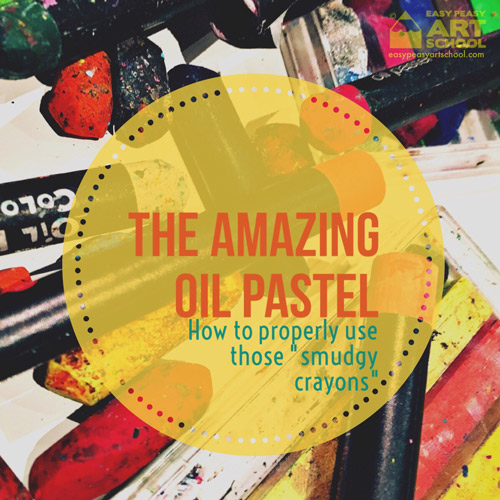 [/grid_content][/grids][/tatsu_column][/tatsu_row][/tatsu_section]
[/grid_content][/grids][/tatsu_column][/tatsu_row][/tatsu_section]
Using Ink With Your Class
[tatsu_section padding= "90px 0% 90px 0%"][tatsu_row column_spacing= "" row_id= "" row_class= "" equal_height_columns= "1" full_width= "0" gutter= "no" layout= "1/2+1/2"][tatsu_column layout= "1/2"][tatsu_text max_width= "" wrap_alignment= "center" animation_type= "fadeIn"]
It’s not as terrifying as you think!
The idea of using ink in a primary or elementary classroom may conjure terrifying images in your mind of spillages, stained clothes, and smudged artworks. But with a little caution and a bit of preparation, ink can prove to be a wonderful art medium for your class to draw, paint or experiment with.
I’ve used ink for years in my teaching. From Year 6 all the way down to Kindergarten and even special education classes. All of my students have loved the experience of using ink to create artworks.
[sc name="Brushes" color="red" content="Benefits of using ink:" ]
One of the benefits of using ink is its ability to help in the teaching of brush technique. You can paint much longer, thinner or thicker lines and all with one brush when using ink.
Ink can also be used beautifully when teaching students about value - light and dark in an artwork.
Students can mix ink with varying amounts of water or other colours to create lighter or darker shades in their work.
You can also use ink with different painting and drawing implements. You can paint with a brush, draw with a nib or stick and even blow ink with a straw to create different effects.
It’s ability to be used as both a drawing and painting medium can really help in adding more detail in a painting rather than when you use paint.
[sc name="Brushes" color="blue" content="What type of Ink should I use?" ]
Ink comes in different types but with younger children you should use water based drawing ink. It is easy to mix with water and easier to clean up.
You can get ink in many different colours but sometimes it’s great to use just one colour mixed with water or white ink to create monochromatic artworks.
[sc name="Brushes" color="green" content="What can I paint with?" ]
Any type of brush works, but I like to use a soft bullet tipped brush. A size 6 works beautifully for both thin and thick lines. You can also paint or draw with larger brushes and even wooden food skewers are great for adding thin scratchy lines.
[sc name="Brushes" color="orange" content="Precautions:" ]
Although ink can be amazing, you do need to take some precautions.
To prevent spills:
- Place small amounts of ink in paint palettes or ice cube trays. Ink goes a long way, so you don't need much. Ice cube trays or palettes are also great because the students can mix new colours.
- Place small bottles of ink inside larger containers to prevent them form being knocked over.
- Ensure your class is wearing paint shirts or aprons.
- Table covers or newspaper are a necessity.
- Ensure that students clean their hands and brushes throughly when competed.
Don’t be scared of ink. It’s well worth the precautions and a touch of pre-lesson anxiety![/tatsu_text][/tatsu_column][tatsu_column layout= "1/2"][grids column= "1" border_color= ""][grid_content icon= "" icon_size= "medium" icon_color= "#95d600" animation_type= "fadeIn"]
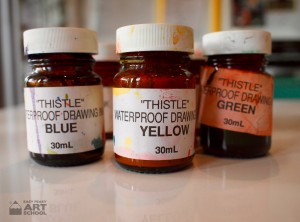

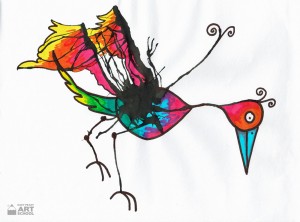


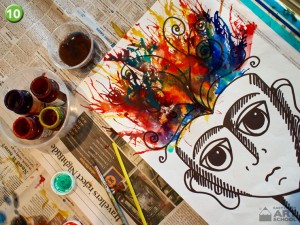 [/grid_content][/grids][/tatsu_column][/tatsu_row][/tatsu_section]
[/grid_content][/grids][/tatsu_column][/tatsu_row][/tatsu_section]
The Importance Of Looking At Art With Your Class
[tatsu_section padding= "90px 0% 90px 0%"][tatsu_row column_spacing= "" row_id= "" row_class= "" equal_height_columns= "1" full_width= "0" gutter= "no" layout= "1/2+1/2"][tatsu_column layout= "1/2"][tatsu_text max_width= "" wrap_alignment= "center" animation_type= "fadeIn"]
It’s just like cooking scrambled eggs!
I love food probably even more than I love art! So it is no wonder that I often use analogies or similes in my visual arts teaching that revolve around food. For example, I often use the terminology “ingredients of an artwork” or an artwork’s “recipe” when discussing or referring to the elements and principles of art. When teaching, we often introduce concepts that our students struggle to understand and so explaining something in terms or by using a comparison they may understand can make the world of difference.
[sc name="Brushes" color="red" content="Scrambled Eggs:" ]
The other day whilst teaching, I was showing a class a painting by Vincent vanGogh and discussing his different way of using brushstrokes which was going to be the focus of the lesson. A rather impatient student in the class put up his hand to ask a question. He asked me why we had to look at the picture and when we were going to start painting our own. Rather than be upset or frustrated with the student, I saw this as an opportunity to impart some food-simile related wisdom.
I began by explaining to my class that I love to cook. I especially love to cook scrambled eggs. Every Sunday morning I get up, make some coffee and cook my scrambled eggs. I have always believed that my scrambled eggs are pretty damn good and I have always made them the same way. I would have probably continued to make my eggs the same way except for the fact that a few Sundays ago instead of cooking my eggs I went out to a cafe for breakfast, where guess what, I ordered scrambled eggs! When my order arrived and I began eating, I had to admit that these eggs were the best scrambled eggs that I had ever eaten. There’s not much that goes into scrambled eggs, so as I ate I decided I would work out what the chef had done differently to me to make them so great. I decided that what made the difference was the way that the chef had gently folded the eggs rather than scrambling them all up. It was also the small addition of some herbs and olive oil drizzled over the top.
Whilst making myself hungry reliving the story, I also then went on to explain that the following Sunday when it came time to cook breakfast, how I incorporated my new favourite eggs into the way I made mine. Whilst my old eggs were great and It would have been ok to keep making them the same old way, it was also great that I got to see how someone else tried to cook the same thing. By looking at and experiencing the way that other people do things be it cooking or art we can learn new ways of doing things to improve the way that we do our own.
Encourage your students to look at art by other artists. By looking at the how - how artists have created their art and thinking about the why - why artists have done things in certain ways, we can improve on our own art making and make even more amazing ‘scrambled eggs!’[/tatsu_text][/tatsu_column][tatsu_column layout= "1/2"][grids column= "1" border_color= ""][grid_content icon= "" icon_size= "medium" icon_color= "#95d600" animation_type= "fadeIn"] [/grid_content][/grids][/tatsu_column][/tatsu_row][/tatsu_section]
[/grid_content][/grids][/tatsu_column][/tatsu_row][/tatsu_section]
How Do I Teach Art To My Class?
[tatsu_section bg_color= "" bg_repeat= "repeat" bg_attachment= "scroll" bg_position= "top left" bg_animation= "none" border_color= "" bg_video_mp4_src= "" bg_video_ogg_src= "" bg_video_webm_src= "" overlay_color= "" section_id= "" section_class= "" section_title= "" full_screen_header_scheme= "background--dark" padding= "0px 0% 0px 0%" border= "0px 0px px 0px"][tatsu_row column_spacing= "" row_id= "" row_class= "" equal_height_columns= "1" full_width= "0" gutter= "no" layout= "1/2+1/2"][tatsu_column layout= "1/2"][tatsu_text max_width= "" wrap_alignment= "center" animation_type= "fadeIn"]
Tips of experience on achieving great results from your art lessons.
As a teacher of visual arts education to future teachers, I’m often asked by them “How do you teach art to your class?” There is no easy answer to that question but rather a set of guiding principles which direct my teaching. So if I were to break it down into a list of must dos for those who would like to improve their teaching of the visual arts, here it is:
[sc name="Brushes" color="orange" content="Your Mind Set:" ]
Set high expectations for yourself and for your students of what they can achieve. They may be kids, but they can surprise you everyday with what is possible.
Learn to value that Visual Arts is not just about making a pretty picture for your classroom wall, it is a learning opportunity.
[sc name="Brushes" color="blue" content="Planning:" ]
Plan and program sequential activities that build on knowledge and skills.
Plan units of work that enable students to experience the various art forms and different subject matter and also that focus on developing an understanding of the ‘ingredients’ of a successful artwork.
Plan realistically based on the availability of materials and resources in the school.
Plan interesting and fun units of work that combine both making and appreciating.
Do the research! Learn about the materials and the artworks being discussed beforehand. Give yourself the background knowledge.
[sc name="Brushes" color="green" content="Organisation:" ]
Be organised, set up and prepared for your lesson and organised for the pack up routine.
Anticipate what problems may arise in your lesson and put things in place to minimise the chance of it happening.
Have a try yourself beforehand. Don’t be afraid of what the students may think of your work.
[sc name="Brushes" color="yellow" content="Teaching:" ]
Develop and practise your classroom management skills to ensure safety, to prevent mess or accidents and to maximise the success of your lesson.
Provide both direct teacher instruction and opportunities for students to freely create.
Break down activities step by step where needed and put directions into terms that the students can relate to or understand. (Use similes!)
[sc name="Brushes" color="red" content="Regularity:" ]
Make or create on a weekly basis in varying art forms using a variety of materials. Don’t let your art lessons be swept away by a busy curriculum. Make time for it!
[sc name="Brushes" color="purple" content="Appreciating and Discussing:" ]
Develop students skills in appreciating their own artworks to learn from their successes and failures. Talk about their artwork with them.
Ensure that students appreciate the artwork of others and their classmates in a positive way. To learn from the successes and not so successes of their classmates.
Appreciate the artworks of artists; the features, the purpose, the history, the cultural significance , etc. Students find it rewarding and interesting and it provides both a starting point and a reference to the ‘Ingredients’ of artworks.
[sc name="Brushes" color="ltgreen" content="Feedback:" ]
Provide positive, yet honest and constructive feedback to your students so that they can begin to critically reflect on their own work.
Celebrate student achievement through encouragement and the display of artworks.
By boosting self-esteem and confidence as an artist — “Every child is an artist. The problem is how to remain an artist once he grows up.” Picasso
[sc name="Brushes" color="orange" content="Assessment:" ]
Recognise through ongoing assessment and student work samples, areas of need then modifying your teaching and planning accordingly.[/tatsu_text][/tatsu_column][tatsu_column layout= "1/2"][grids column= "1" border_color= "#000000"][grid_content icon= "" icon_size= "medium" icon_color= "#95d600" animation_type= "fadeIn"]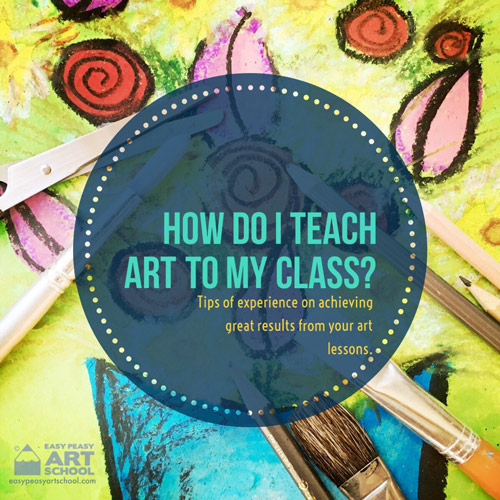 [/grid_content][/grids][/tatsu_column][/tatsu_row][/tatsu_section]
[/grid_content][/grids][/tatsu_column][/tatsu_row][/tatsu_section]
A Recipe For Success: The importance of teaching the elements and principles of art.
[tatsu_section bg_color= "" bg_repeat= "repeat" bg_attachment= "scroll" bg_position= "top left" bg_animation= "none" border_color= "#000000" bg_video_mp4_src= "" bg_video_ogg_src= "" bg_video_webm_src= "" overlay_color= "" section_id= "" section_class= "" section_title= "" full_screen_header_scheme= "background--dark" padding= "0px 0% 0px 0%" border= "0px 0px px 0px"][tatsu_row column_spacing= "" row_id= "" row_class= "" equal_height_columns= "1" full_width= "0" gutter= "no" layout= "1/2+1/2"][tatsu_column bg_color= "" bg_repeat= "repeat" bg_attachment= "scroll" bg_position= "top left" bg_video_mp4_src= "" bg_video_ogg_src= "" bg_video_webm_src= "" overlay_color= "" animate_overlay= "none" link_overlay= "" vertical_align= "middle" animation_type= "flipInX" column_id= "" column_class= "" padding= "0% 0% 0% 0%" margin= "0px 0px 0px" layout= "1/2"][tatsu_text max_width= "" wrap_alignment= "center" animation_type= "fadeIn"]
Becoming an artist is a little like becoming a chef..
[sc name="Brushes" color="red" content="The Ingredients and Recipe" ]
Much like a trainee chef, visual arts students need to learn about ingredients – the ingredients of a pleasing artwork. The characteristics of ingredients, how they react with one another, and what ingredients they need to add to make their artworks ‘taste’ or look better. Too few or too many ingredients or ingredients used in poor ways, results in an unsuccessful recipe or unsuccessful artwork.
We want our students to be able to look at their own artworks and know what ingredients (elements of art) they need to use to communicate their message and to make it a success. We also want our students to develop the knowledge of how to use these ingredients to put the ingredients together into a successful recipe.(Principles of art.)
Much like chefs with successful recipes or inedible meals, students learn and develop as artists by their successes and failures. In each and every artwork, they learn about what ingredients worked well and what ingredients they would use differently the next time they create. An unsuccessful artwork is not a failure but an opportunity to learn.
As a teacher of the visual arts, over time, your responsibility is to provide making and appreciating activities that:
- Give the students the knowledge and understanding about these ingredients through direct instruction of their use and through the appreciation of their own artworks and the artworks of others.
- Give students the skills to put this knowledge of ingredients into practice, through the exploration of different subject matter, art forms and mediums in both directed and self-directed activities.
[sc name="Brushes" color="green" content="The ‘Recipe’ to a successful artwork:" ]
The Ingredients: Elements of Art
- Line
- Shape
- Colour
- Space (2D)
- Tone/Value
- Texture
- Form (3D)
The Recipe: Principles of Art (Composition – How we put the ingredients together)
- Balance
- Contrast
- Emphasis
- Movement
- Pattern
- Rhythm
- Unity
[sc name="Brushes" color="purple" content="'What will they learn?" ]
It is essential to provide students with an understanding of the purpose of the lesson. Yes creating art is supposed to be fun and enjoyable, but don't waste the opportunity of learning by just creating a pretty picture with no understanding. What will they learn from creating the artwork? What will be the skills they focus on and what knowledge especially about the elements and principles will they gain? I always write the learning intention of each artwork on the board as part of my lessons.
[sc name="Brushes" color="green" content="'How will they know they have succeeded?" ]
One of the difficulties of teaching visual arts is overcoming the subjective nature of what is created. We've all had a student frustratingly come up after five minutes to inform us that their artwork is 'done' with little effort or thought demonstrated in their work. To the teacher, the artwork may seem incomplete. But have we actually provided the class with a clear understanding of what they need to do for the task to be considered complete whilst still allowing them the creative freedom to complete it in their own way?
The way to achieve this is to provide students with a 'Success Criteria.' What do they need to demonstrate in their artwork for it to be complete? For each lesson I clearly display a success criteria. This criteria is based on the purpose of the lesson and is usually broken down into three basic headings.
- Skills: I write one or two criteria based on what I would be looking for to show me that they have successfully learnt the skills being focused on. For example one criteria may be that I am looking for crosshatching to show shading in their drawing.
- Knowledge: Because the elements and principles are the building blocks of all artworks, I like to include criteria that focus on their use in the task. For example, one criteria may be that I'd like to see a variety of different lines in their artwork; thick, thin, light and dark.
- Effort: What will show me that the students have put in their best effort? For example, I may include the criteria that the artwork needs to show no white spaces or that they have used the whole page in their drawing.
[sc name="Brushes" color="orange" content="'Tasting' the Recipe" ]
As a chef cooks, they taste their food and make decisions about what they need to add to make it tastier. As an artist, we don't taste our artworks, we look at them. We look, self reflect and make decisions about what needs to be added as we work on our creations. This ability to self-reflect comes both naturally and through explicit teaching.
When you examine the drawings of very young children, it is clear that even at an early age they make decisions on what to add to their drawings to make it more appealing or to help tell the intended story. A young artist might add a sun or birds in the sky to show that they are drawing someone outside. However, their drawings remain simple. This is partly due to their developmental stage but it is also because they lack the experience with mediums and techniques and also because their knowledge of the visual elements and principles is limited.
By explicitly teaching students the visual elements and principles through a variety of artworks, we give students a back catalogue of 'ingredients and recipes.' A catalogue of knowledge and skills and a catalogue of successes and failures on which they can call on to improve the artwork they are currently working on. A student's frustration or perception that they 'can't draw' comes from the fact that they don't have the knowledge or that they don't know how to self-reflect on what they need to do next to make it better.
[sc name="Brushes" color="green" content="'How does this work in the classroom?" ]
The easiest answer, is through meaningful and positive feedback, questioning and encouragement.
Whenever a student brings their work to share with me or when I am walking around the room assisting them with a task I make sure that my comments are meaningful. Simply telling the student that his or her artwork is nice or beautiful, tells them nothing. I always make sure that my feedback involves their use of the visual elements or principles.
Instead of simply telling a student that their artwork is beautiful, I might say for example, "Oh, Andy this artwork is beautiful. I love the way that you have used both thick and thin lines in your drawing. It really helps to emphasise the different shapes in your work."
Or if I think a student's work looks incomplete I might say, "Hey Andy, that's a great tree but do you notice any spaces in the background where it looks like something is missing?" "What could we put there so that the viewer has something to look at?"
I might even refer to a previous lesson, " Hey Andy, do yo remember that cactus lesson we did where we learnt how to blend oil pastels? What do you think you may have forgotten to do in this artwork?"
[sc name="Brushes" color="yellow" content="What do you like about your artwork?" ]
My favourite questions by far though are the two that I ask all students to self reflect on at the end of a task. They are:
- What do you like about your artwork?
- What would you do differently next time?
By building this self refection into every lesson, it encourages students to think about how they might improve in future artworks. At the end of each lesson, I do this in a number of ways:
- I may ask a student these questions as they bring their completed work to me. This works great for those students who are shy or lack confidence.
- Sometimes I ask students to self reflect on these questions but to keep the answers to themselves. I do this to build the understanding that these are questions that we ask and answer ourselves.
- If time permits, I love to pose these questions but then ask targeted students if they'd be willing to stand in front of the class and share their work. This is a great way to boost an individual student's confidence. I usually begin the discussion and talk about why I like the artwork. I then ask the remainder of the class what they like about the artwork being shared. I encourage peer feedback to be on the use of the elements and principles or on the success criteria not just comments such as 'It's nice.' Through my experience, this practise really helps to boost a young artist's confidence. Hearing their peers identify positives about his or her work may help a student to see that there are many great aspects to their work when previously they may have thought there were none.
- I never allow the student's peers to comment on what they don't like about the artwork. Rather, I ask the student who created the work to share what they think they would do differently next time.
[sc name="Brushes" color="blue" content="How do we show others what we've learnt?" ]
Written student reflection accompanying artworks and in particular on their use of the elements and principles is a fantastic tool for demonstrating evidence of student learning in the visual arts. Whether this be for an assessment work sample or as part of the artwork display. Students can write on coloured shapes or bubbles what they learnt from completing the task or comment on how they used the elements and principles. When other people see what the students have written they will see that real learning has taken place and that it's not just a pretty picture.[/tatsu_text][/tatsu_column][tatsu_column layout= "1/2"][grids column= "1" border_color= "#000000"][grid_content icon= "" icon_size= "medium" icon_color= "#95d600" animation_type= "fadeIn"]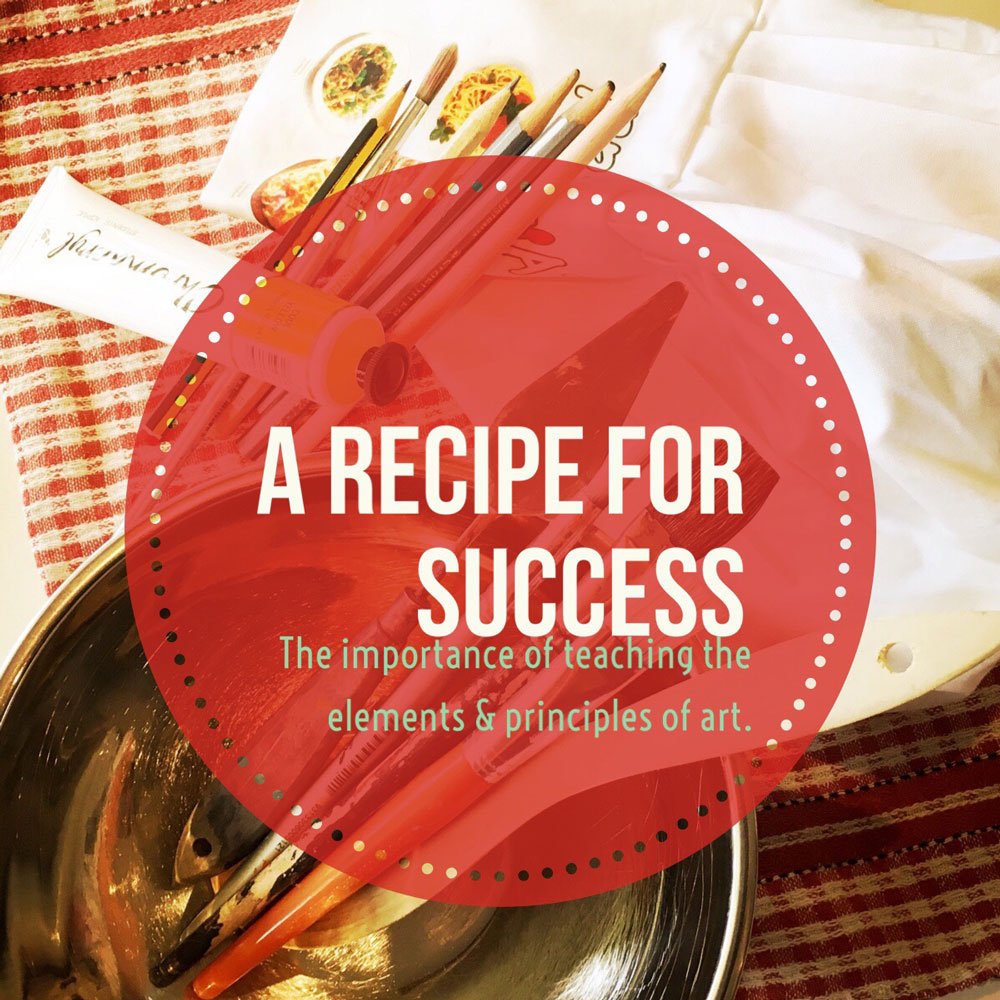
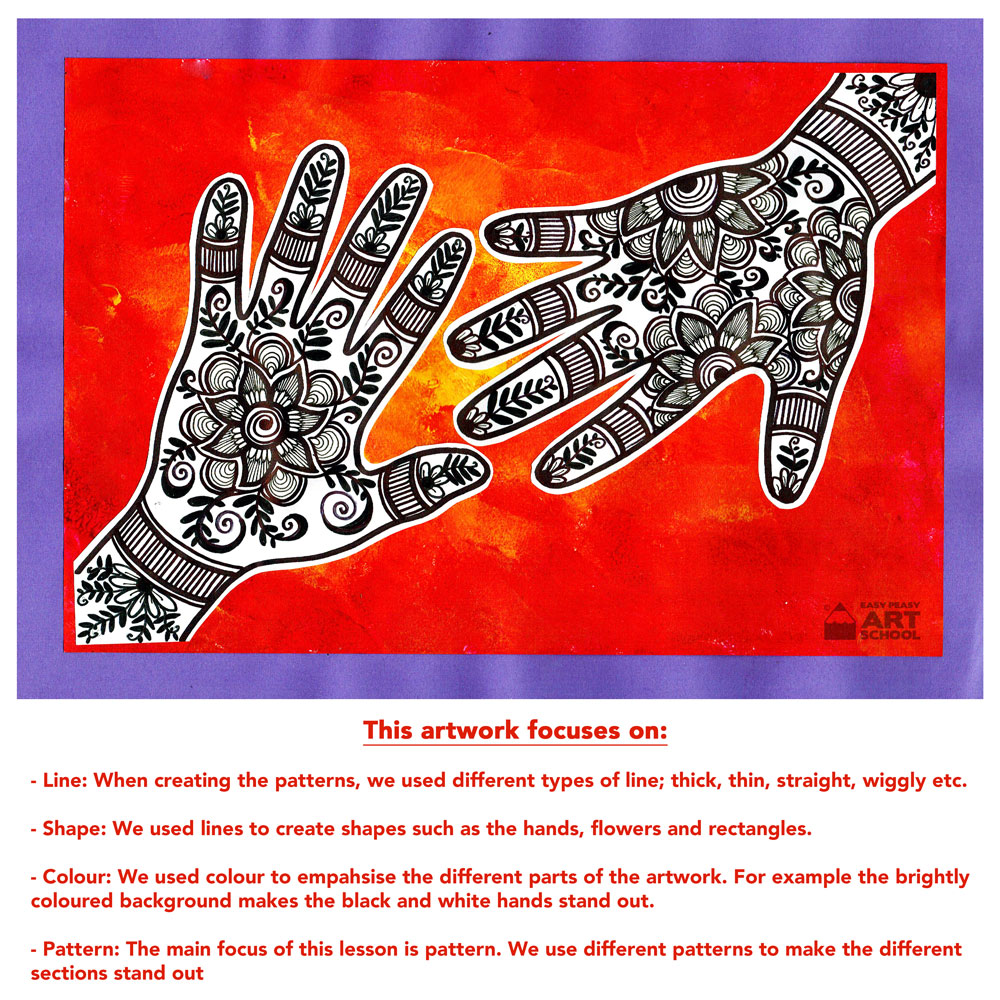

 [/grid_content][/grids][/tatsu_column][/tatsu_row][/tatsu_section]
[/grid_content][/grids][/tatsu_column][/tatsu_row][/tatsu_section]

